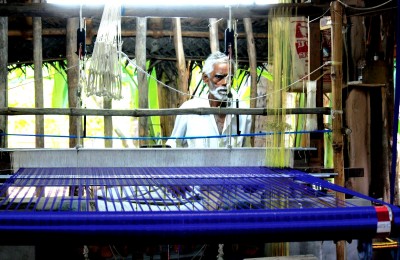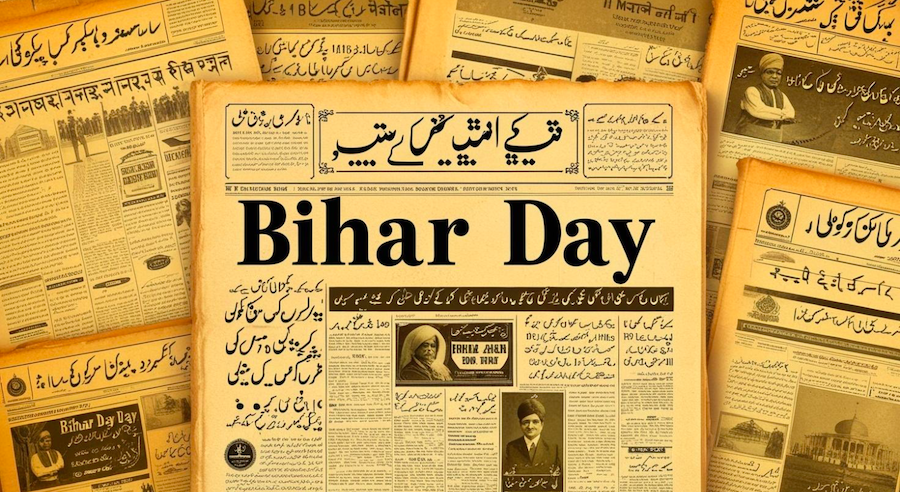Despite many schemes, handloom weavers continue to be a neglected lot…
Congress leader Rahul Gandhi has been shouting from the rooftops about schemes the UPA has introduced to help weavers in UP. But it seems nothing has trickled down to the weavers of Varanasi. Ali Husain Ansari, a weaver, says he has not benefited from the government’s financial package for weavers announced in December 2011.
The UPA government accuses the state government for their plight. While most of the money of the schemes are pocketed by cooperatives, it seldom reaches the target group. ”All the money of the schemes has gone to cooperative societies. It has become difficult to for us to even pay back loans,” Ali said.
There are about 50 lakh weavers in the country. Although their produce are sold at high prices, they seldom gets the benefit. Most of them live in penury and poverty.
Weavers of Tamil Nadu too have lurched from one crisis to another, surviving on the strength of their resilience. The cooperative movement, started in the 1950s to help weavers tide over frequent crisis situations, and Cooptex, the apex marketing society, set up to promote handlooms, have been undermined systematically over the years. Politicisation of the cooperative set-up, with successive governments dissolving the elected boards and filling the societies with their own party men, has weakened the movement. Cooptex, far from being a promotional agency, has been transformed into a mere marketing agency.
Tamil Nadu, accounting for nearly 30 per cent of the country’s handloom textiles production and 50 per cent of exports, has over six lakh handloom units and 1,400 cooperative societies. Handloom weaving with products ranging from duster cloth to silk saris, is a common occupation throughout the State, except in the Nilgiris district.
Over 50 per cent of the weavers are in the cooperative fold and the majority of them produce dhotis and saris for the Janata cloth scheme. The offtake under the scheme, which distributes saris and dhotis to the poor, was substantial. Among the traditional centres associated with this scheme are Srivilliputhur and Rajapalayam in Virudhunagar district; Andipatti in Madurai district; Ammayarkuppam and Arani in Thiruvallur district; and Kezhkodungalur in Tiruvannamalai district.
Handloom weavers have been representing their problems to the government but their pleas have elicited nothing more than temporary measures. And as the situation began to deteriorate early this year, they organised dharnas and agitations at the local level. When everything failed, and their families faced starvation, the weavers of Srivilliputhur set up community gruel centers on July 22. Soon more gruel centers came up in traditional weaving centers. Under the programme, which started from within and in which the entire community is participating, a group of youngsters goes around the village collecting food grains, pulses and vegetables, prepares gruel in a common kitchen, and supplies it to the weavers’ families once a day. Workers’ organisations, such as the LIC Workers Union, have been helping with necessary food materials.
If the handloom industry has thus far survived competition from the power looms, the liberalised policy regime, market instability and government apathy, it is largely because of its own resilience. Now with demand disappearing for traditional handloom products owing to changing consumer preferences, poor marketing facilities, dearth of knowledge, skills and technical expertise to adapt to changing demand and lack of infrastructure to upgrade the looms, the handloom sector is a shambles. If the industry, the second largest employer in Tamil Nadu after agriculture, is to survive and the lakhs of weavers’ families are to be saved from their desperate situation, it needs to be re-oriented with sound government support.
The commerce and industry ministry had announced a Rs.2,350 crore package for weavers to bail weavers out of distress. But the weavers say government packages to bail them out have passed them by.
Husain said hundreds of Mughal textile weavers in Varanasi and in the villages around it have switched to pulling rickshaws to fend for themselves. He and thousands of his fellow weavers in Varanasi depend on “resham” threads from “Korea” and yellow “tussar” from China. “Their prices fluctuate between Rs.1,680 and Rs.4,500 (per bale). A loan of Rs.25,000 to 50,000 is not enough,” he said.
The muga weavers of Assam are fighting against farm pesticides that are killing muga silk worms in their habitats in Upper Assam. Muga, one of the costliest and rarest varieties of silk, is known as “the golden fibre of Assam”.
“The volume of fibre extracted from silkworms has decreased over the years with muga worms dying of chemicals that farmers in Upper Assam spray in their fields,” said weaver and crafts activist Kusum Lashkar, who manages the NGO Shanti Sadhana Ashram in Guwahati.
The effect of the pesticides spreads far and wide and destroys silk farms. “The constrained production has led to an increase in prices of muga silk by almost 50 percent,” Lashkar claimed. The muga weavers of Assam have been facing a demand-supply gap over the last few years, the weaver said.
Such tales of neglect, poverty and poor implementation of government projects at the grassroots fought for attention with a colorful spread of handloom products at “Kargha Yagya” at the sprawling Gandhi Smriti Feb 23. The textile showcase was in memory of Kasturba Gandhi, the woman who spun the charkha alongside her husband Mahatma Gandhi.
An unknown community of sheep wool weavers in Jharkhand – the Behriyar-Gareriya nomads from the Gaya district in Bihar – has almost given up its traditional craft of blanket weaving for lack of funds.
“We weave blankets from sheep wool collected from our herds of sheep. But the state government (the state handloom and handicraft corporation Jharcraft) has turned its face away from us and we cannot compete with the blankets being sold in the markets. Our blankets cost Rs.300 each in the market while each blanket costs Rs.350 to weave. We are forced to sell our products in villages because of limited access to urban markets,” Iqbal said.
The community of 75 wool weavers’ families lives in two villages – Mahwawdavan and Barawad in Madhupur block. Bhagat, whose family owns a herd of 500 sheep, says “the near-death of the blanket weaving tradition has killed the barter system of economy that helped the villagers sustain”.
Ajay Singh, a weaver from Bhagalapur in Bihar, known as India’s silk city, said “the government should work directly with communities of weavers in villages for holistic welfare of the communities”.
He demanded a “residential school for the childern of weavers where they would learn their native tongue, the national language and an international language to compete in the global market”.
Mohammed Mominul Islam and Riaz-ul-Haq, silk weavers and textile designers from Malda in northern West Bengal, complain of poor accessibility to markets and design interventions.
“This is our first visit to Delhi. We realised after coming here that saris are not in demand in northern India; girls prefer silk ‘salwar-kameez’. We have to improvise on our range to make textile-lengths for ‘salwar-kameez’,” Ansari said. Malda produces 80 percent of Bengal’s silk in three clusters – Sujapur, Jalalpur and Kaliachowk.
“People have forgotten the Gandhian lesson – production by mass for mass. Buyers would rather go to malls for designer labels. They should have access to more markets, resources and raw material,” said Manimala, director of the Gandhi Smriti and Gandhi Darshan at Rajghat in the capital.
Citing statistics, Manimala said, “The country has nearly 25 lakh (2.5 million) handlooms employing 50 lakh (5 million) people and about 60 percent of them subsist below the poverty line”.
Kerala has around 50000 handlooms both in the private sector and in over 750 cooperative societies provide employment to about 1.25 lakh weavers. Kerala State Handloom Weavers Cooperative Society (HANTEX), the apex organization of the cooperatives and Kerala State Handloom Development Corporation Ltd (HANVEEV) providing services (especially marketing) to individual weavers, are the principal development agencies assisting the Department of Handlooms and Textiles.
The handloom industry faces a serious crisis, owing to (i) competition from cheap power loom cloth from other states (ii) scarcity of quality yarn (iii) price escalation of yarn, dyes, chemicals and other raw materials (iv) the shrinking market for handlooms in Kerala (v) non-demand based production and inadequacy of new designs and (vi) inefficiencies in the system, particularly in the cooperative sector.
The Deen Dayal Hathkargha Prothsahan Yojana (DDHPY) introduced by the Government of India is a comprehensive scheme for the development of the handloom industry. The assistance provided by the Government of India is sometimes insufficient considering the wages and quality of living in Kerala and hence it may be supplemented by State schemes. Welfare schemes of the Government of India will also be popularized and implemented in the above manner.
The traditional industries in Kerala particularly coir, handlooms, khadi, bamboo-based, handicrafts, artisanal and village (cottage) industries etc. are plagued by problems of high cost production, low quality, absence of diversified product range, inappropriate technology and incapacity for professional marketing and export. Increased mechanization, large scale of production and global competition in quality and price pose the threat of massive redundancies in these high employment sectors of Kerala, which may result in poverty and social problems.
To attract private sector investment badly needed in these sectors, a special scheme of investment subsidy with adequate incentives will be implemented, so that our reliance on cooperatives heavily dependents financially on the government for investment (often to the extent of 95% or more) will be reversed. Agencies created primarily as apex organizations and for marketing of traditional industry products like coir, handloom, khadi, cottage industry products, handicrafts etc. will be given programme funding rather than the non- conditional grants and share participation given in the past in order to avoid wastage of scarce Government resources on high overheads and to ensure delivery of their services (particularly marketing) in the most cost effective manner, using private sector finance and initiative at the retail level.
The development and production of value added, diversified and innovative products from traditional industries is proposed to be done by a cluster based approach which will ensure the critical mass for forward integration. Marketing, both domestic and global, is to be promoted by developing brand equity for Kerala’s traditional industry products. Research and development to create new processes and appropriate machinery will be funded on a project-to-project basis with the provision for success fees linked to effective commercialization and commissioning. (Courtesy: Sopan Step)










